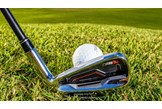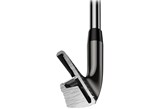How to choose the best golf irons for you
Published:
Many golfers take great care in selecting the perfect driver, but plough on with a set of hand-me-down irons they’ve had for a decade. Considering you’re likely to hit your driver a dozen times in a round, at most, and hit 25-40 iron shots, it makes sense to put a lot of care into choosing the perfect irons for your golf game. If you’re thinking about buying a new set of irons, here’s what you should consider…
Blades, cavity backs or game improvement irons?
Irons come in a vast array of styles, all designed to suit different capabilities. Blades are aimed at the best ball strikers, and offer little to no forgiveness when you don’t hit the centre of the club. Cavity backs are aimed at those wanting a good degree of playability, so off-centre hits are less harshly punished. And super game improvement models tend to have wider soles, more offset and often hollow bodies to offer ultimate forgiveness and help launch shots into the air.
Which ones are best suited to you will depend on your ability, what suits your eye, and your typical impact pattern.
Forged or cast irons?
At some point in their construction both were made of molten metal. Forged irons come from billets of steel stamped under massive force into a clubhead shape. This stamping is said to align the structure more closely for, it’s claimed, better feel. Cast heads are created by molten steel poured into moulds. Casting technology has moved on massively and it’s said heat treatment after casting combined with the type of steel used today mean a cast head can feel very much like a forged.
Should I worry about the type of steel?
Thinking changes from time to time about which is the best. What is more important is trying the irons to see how they feel for you.
Should I consider the sole?
Yes. Wider soles mean more weight lower down, which helps get shots airborne. It also won’t dig as much at impact. Wider soles equal game improvement. Narrower soles tend to be found on better player irons. Some irons now have bevelled soles to allow the club to better interact with the turf and lose less energy at impact.
What does offset do?
Larger amounts of offset is usually found in game improvement irons. It sets the face behind the hosel, giving a little more time to square the face at impact. Better player irons generally have less offset so the leading edge is much more in line with the hosel. This makes the club a little easier to ‘shape’, as the centre of gravity is further forward, hence why shot shapers often love forged irons.
Is gapping important?
Yes. While manufacturers ensure you have accurate gaps between each iron, you need to look at the gap between the longest iron you’re comfortable hitting and the next club you have, whether it be a fairway or hybrid. Don’t have a couple of clubs that go the same distance. You should also consider the gap between your shortest iron and any wedges you have – you want to have standard gaps here of, say, 10-15 yards at the most.

Do hollow body irons work?
They are growing in popularity, as they deliver the same sort of playability benefits as woods/hybrids. Typically the heads are made in a couple of pieces with the springy steel faces welded on. If you find hybrids easy to hit and want lots of playability and distance in one, a hollow body Callaway Big Bertha or Nike Vapor Fly might be a decent option.
Why are shafts now lightweight?
Steel iron shafts have got lighter. It wasn’t long ago Dynamic Gold shafts were the norm and they weigh over 120g. Standard stock steel shafts are now 80g-90g. Why? Manufacturers say if a shaft is lighter and you swing at the same speed the club is going to travel faster, increasing distance.
Custom-fit or off the shelf golf irons?
Custom-fit. You wouldn’t buy a pair of shoes or suit without getting your correct size, so why buy a set of clubs without being fitted?
Are multi-material heads the saviour?
Manufacturers employ fancy metallurgy and materials science to come up with new ways of improving forgiveness. Whether it’s light metals, alloys or Nike’s RZN material, all are moving mass away from ineffective areas of the club to areas where it can improve stability, stiffness or flexibility.
Will a lighter or heavier iron give me more power?
A new kinetic energy theory is seeping into whole ranges of golf clubs. Effectively it’s all about swinging at the same speed, but getting the head travelling quicker at impact. The thinking reduces shaft weight (or plays with its profile so weight is nearer the head) and increases head weight to allow golfers to gain extra clubhead speed even though they swing at the same pace. We’ve tested a few ranges designed on this principal and they’re really effective. If you describe your swing as an average to slower speed, Yonex’s E-ZONE XPG or Srixon’s Z355 ranges could be right up your street.


